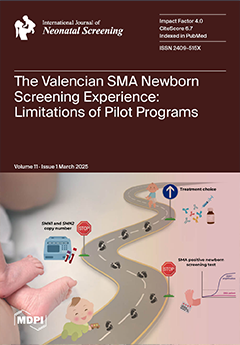Open AccessConference Report
Consolidated Newborn Bloodspot Screening Efforts in Developing Countries in the Asia Pacific—2024
by
Bradford L. Therrell, Carmencita D. Padilla, Michelle E. Abadingo, Shree Prasad Adhikari, Thuza Aung, Thet Thet Aye, Sanjoy Kumer Dey, Muhammad Faizi, Erdenetuya Ganbaatar, Tran Thi Huong Giang, Hoang Thu Hang, Rathmony Heng, Seema Kapoor, Khurelbaatar Nyamdavaa, Prajwal Paudel, Kimyi Phou, Aman B. Pulungan, Chittaphone Sayyavong, Salimah R. Walani and Tariq Zafar
Cited by 4 | Viewed by 5769
Abstract
Approximately half of all births globally occur in the Asia Pacific Region. Concerted efforts to support local activities aimed at developing national newborn screening (NBS) have been ongoing for almost 30 years, first by the International Atomic Energy Agency (IAEA) and then through
[...] Read more.
Approximately half of all births globally occur in the Asia Pacific Region. Concerted efforts to support local activities aimed at developing national newborn screening (NBS) have been ongoing for almost 30 years, first by the International Atomic Energy Agency (IAEA) and then through volunteer efforts. Sustainable newborn bloodspot screening (NBS) continues to be initiated and develop in many of the countries with developing economies in the region. Since the discontinuation of IAEA funding in 2007, a working group of the Asia Pacific Society of Human Genetics (APSHG) consisting of interested representatives from countries in the region with less than 50% NBS coverage has participated in periodic workshops to exchange information, set goals, and provide peer support. Facilitated by international NBS experts, interested corporate sponsors, and the APSHG, the 7th workshop of representatives from 10 East Asian countries with developing NBS systems was recently held in Kathmandu, Nepal. This report summarizes the NBS activities in these countries and describes the continuing efforts to move NBS ahead in the region.
Full article
►▼
Show Figures






